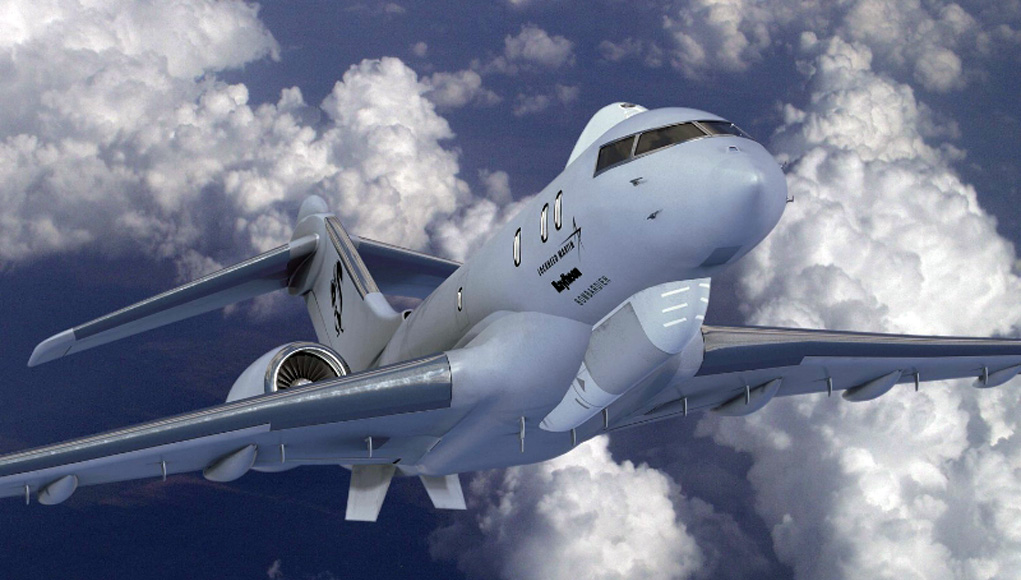Lockheed Martin is leading an industry team that includes Raytheon and Bombardier, addressing the U.S. Air Force requirement to recapitalize and modernize the Joint Surveillance Target Attack Radar System (JSTARS), currently operating on obsolete Boeing 707-300 based platforms introduced in 1991. Lockheed Martin will serve as the lead systems integrator for the program and Raytheon will bring to the team their experience with ground surveillance, intelligence, surveillance and reconnaissance systems, mission systems integration, and JSTARS communications. The team promises to deliver a low-risk, affordable solution bass on business aircraft produced by Bombardier. Raytheon and Bombardier have already joined forces on the ASTOR Sentinel R1 program for the UK, using Bombardier’s Challenger 604.
Bombardier’s ultra-long-range Global business jet platform suggested for the recap is less expensive to operate than modern airliners, the company stated. It is uniquely suited to the JSTARS mission by allowing the on-board radar to see further and deeper into valleys and survey the battlespace for extended periods of time without refueling.
The U.S. Air Force is already operating the Global 6000 platform as an airborne relay, under the Northrop Grumman lead Battlefield Airborne Communications Node (BACN) program, an application making the Bombardier Global platform “very well-positioned in this market segment,” added Stéphane Villeneuve, vice president, Specialized Aircraft, Bombardier Commercial Aircraft.
“Embracing the United States government’s desire for strong industry partnerships, the Lockheed Martin-led team will provide the Air Force capabilities superior to the current JSTARS.” The team announced in a statement. “The team will also deliver a true open system architecture to allow the government to own the technical baseline for future upgrades and reduce life cycle cost.”
“Our track record of performance in systems integration and leadership in Open Mission Systems, combined with our teammates’ relevant products and in-depth experience, give us confidence that we can provide the Air Force the best possible solution,” said Rob Weiss, executive vice president and general manager, Lockheed Martin Aeronautics, Advanced Development Programs (the Skunk Works). The sensor package remains shrouded in secrecy. According to Aviation Week, the new configuration will use scaled version of an existing radar developed by Raytheon in the classified world, says Eric Hofstatter, Lockheed Martin Skunk Works JStars recap program manager.
Northrop Grumman, the prime contractor of the original E-8 has formally partnered with Gulfstream and L-3 on its offering to the US Air Force Joint STARS recapitalization effort. Northrop Grumman has used the G550 as a test bed for JSTARS technology. L-3 will provide the necessary modifications adapting the ‘green’ G550 for the JSTARS mission. According to Tom Vice, corporate vice president and president, Northrop Grumman Aerospace Systems, the company can “meet, or exceed, the Air Force’s acquisition requirements by integrating our team’s independently developed, mature and proven systems at the lowest cost, with the lowest risk to provide an innovative acquisition solution.”
The Air Force currently operates 18 E-8 JSTARS platforms. Each carries a synthetic aperture ground surveillance radar providing long-range surveillance and detection of moving targets on the ground, covering a large area, up to 124 miles deep. These sensors locate, track and classify ground vehicles. The U.S. Air Force plans to recapitalize its 16 E-8C Joint Surveillance Target Attack Radar System aircraft with 17 new jets.
Boeing is also proposing a solution for the recap, based on a modified 737-700 commercial airliner as its offering. While bigger and more expensive to operate, this platform could offer future growth capacity, Boeing argues.




















